Skip to content
Lending Rules for Homes with “Oversized Lots” or Land
Lending Rules for Homes with “Oversized Lots” or Land
 Conventional, FHA, and VA lending have relaxed underwriting rules over the last ten years to make loans on “small houses with oversized lots” or acreage.
Conventional, FHA, and VA lending have relaxed underwriting rules over the last ten years to make loans on “small houses with oversized lots” or acreage.
Typical Lending Rules for Homes with “Oversized Lots/ Acreage”
With lot splitting a costly, tedious process and ADU construction rising in the suburbs, many buyers are looking for older homes with buildable lots.
Whether to house an aged family member, domestic help, or rent out for extra income –oversized lots are a hot item.
Also in demand are county properties near expanding suburbs that can be built upon before cities incorporate and land use restrictions drafted and enforced.
Why Many Lenders Don’t Fund Land/ Lot Loans
Regulators, investors, and creditors prohibit lending to them because:
(1) Land/Lot loans are much riskier because land values are more volatile due to the land use activity of adjacent landowners:
(2) Land/Lot loans are more speculative – leading to more (potential) defaults:
3) If the land/lot is foreclosed, the parcel(s) are less liquid as collateral;
4) Future Zoning issues are more prevalent, volatile, and less “predictive”:
5) More expertise is required to appraise;
6) Land is more difficult to understand and utilize to its total value.;
7)The ongoing maintenance of “oversized lots can place a financial burden on buyers;
Note: One other issue no one likes to talk about is rural – semi-rural properties have sometimes been used as marijuana farms; although legal in California, the FEDs may decide to arrest the occupants and seize the land.
Another issue is meth labs, as large-scale chemical processing demand facilities be hidden from prying eyes (and noses), making these properties advantageous to criminals laundering drug money by purchasing the land or renters posing as just wanting to get away from the city.
Fannie and Freddie no longer have any “hard” limits on lot sizes.
Large lots need to be “marketable” and “typical for the area,”
What are acceptable “land-to-value” ratios? Most underwriters I’ve contacted use 70% as the ceiling, with certain exceptions!
Fundamentally, What’s Typical for The Area
Typical land-to-value ratios in suburban neighborhoods are 25% to 33%. But in high-end suburban and urban areas, they can exceed 50%—which is lendable if “typical for the area.”
Appraisers may note “Effective Lot Sizes” to solve the “too large of a lot” problem. A lot is “effectively” much smaller when the land is steeply sloped, creeks, rivers, gorges run through the property, or major easements severely restrict usage.
Hobby Farm Usage?
Conventional lenders will not lend on large properties with any “commercial farming,” e.g., grape harvesting (common in CA), working cattle or horse operations, etc. “ However, “hobby” farming” is allowable.
If the land/lot is zoned “agricultural,” then a local lending institution or a USDA loan is most likely the best solution for financing.
Share This Story, Choose Your Platform!
 Conventional, FHA, and VA lending have relaxed underwriting rules over the last ten years to make loans on “small houses with oversized lots” or acreage.
Conventional, FHA, and VA lending have relaxed underwriting rules over the last ten years to make loans on “small houses with oversized lots” or acreage.